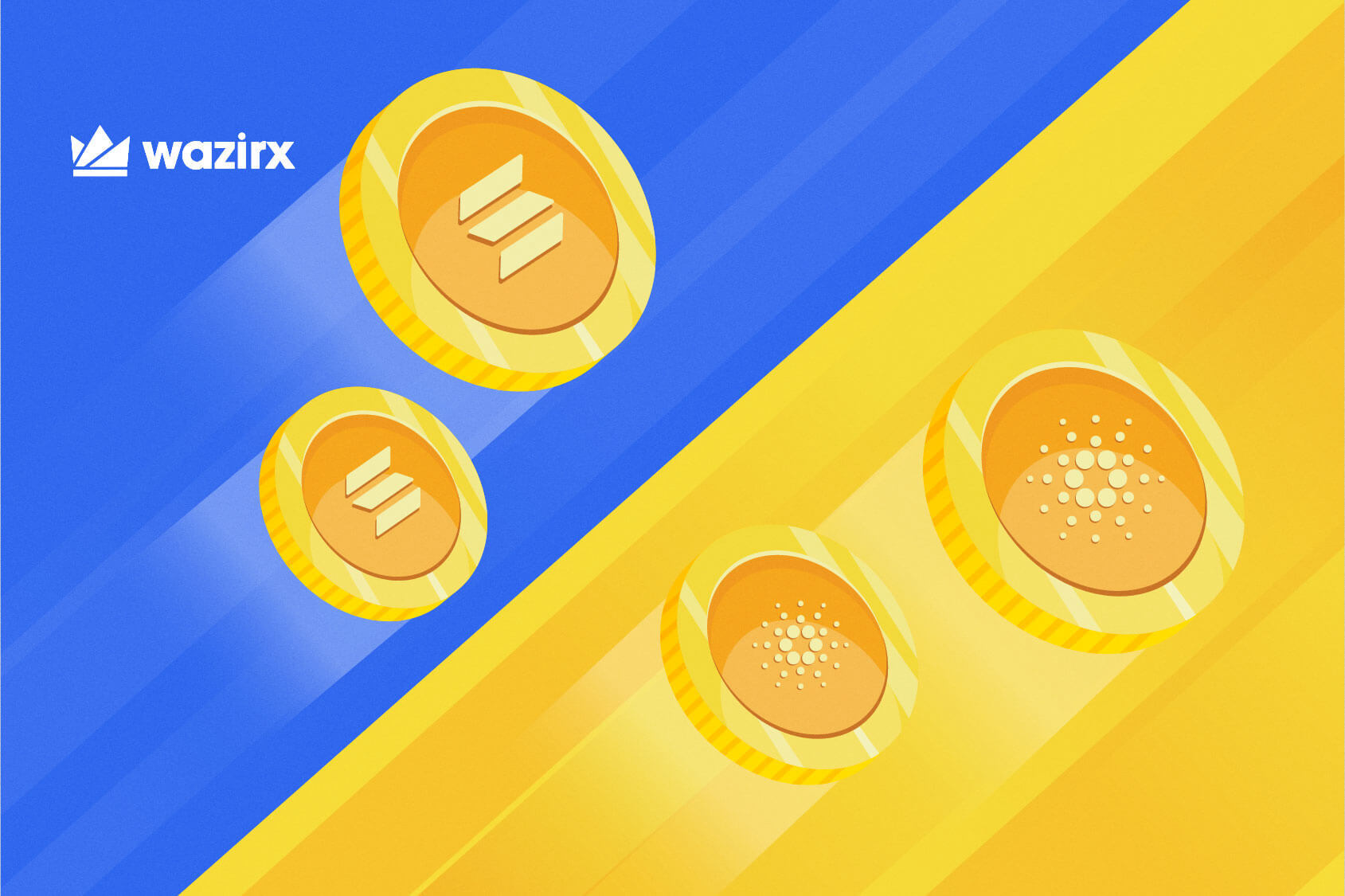[ad_1]
About
Solana
Solana is a layer-1 blockchain protocol that employs the PoH (Proof of History) consensus mechanism before the PoS (Proof of Stake) consensus mechanism to create historical records of time with attached proofs of time or time stamps. The hybrid consensus mechanism grants Solana high transactional throughput of up to 50,000 transactions per second on the network. The throughput can be scaled to 1,00,000 transactions per second as well. Solana doesn’t require any layer-2 scaling solutions as it easily achieves huge computational power on the first layer itself. The blockchain supports the development of decentralized applications or dApps and smart contracts. Over 200 plus projects are currently powered within Solana’s ecosystem, and many more such projects are underway.
Cardano(ADA)
Cardano or ADA is a third-generation smart contract-enabled protocol helping in the creation of the DeFi ecosystem. Cardano uses the Ouroboros consensus mechanism – a verification mechanism by Cardano Foundation where users stake their ADA tokens to participate in the validation process. This mechanism is better than the Proof of Stake mechanism as the staking is only required at the time when a ‘snapshot’ of the network is being taken. At other times the staked ADA can be freely moved around and used to participate within the DeFi.
It increases its transactional throughput via RINA (Recursive InterNetwork Architecture) technique that splits the main network into many subnetworks that communicate among themselves.
Cardano was created by Charles Hoskinson – one of the co-founders of Ethereum, and was co-led by Jeremy Wood.
Despite Cardano being a third-generation protocol, it solves the same scalability issues as Solana, a first-layer solution new on the DeFi scene. Solana is gaining continued traction owing to its greater transaction throughput. Cardano is lagging given the frequent delays in its upgrades, such as the introduction of smart contracts.
Market Capitalization and Performance
Each of the blockchain platforms has a multibillion-dollar market capitalization. Cardano is the fifth-largest cryptocurrency, while Solana is the sixth-largest cryptocurrency in the global crypto market. A larger market cap makes a token safer. However, it cannot be a guarantor against volatility in the crypto markets.
Cardano has a market cap of $64.69 billion, while Solana has $51.47. In terms of volume, both the cryptocurrencies are fighting heads-on. While Solana has a $2.82 billion 24-hour trading volume, Cardano collects only $2.64 billion in its 24-hour schedule as per Coinmarketcap.
The platforms had their star moments, witnessing unprecedented growth in 2021.
Solana began its journey at $2 at the beginning of 2021 and is trading over $200, registering gains of over 10,000%. Cardano’s ADA was worth $0.18 at the beginning of 2021 and is trading close to $2, registering a growth of over 1000% within the same span.
Cardano’s growth can be attributed to the recent addition of smart contract features after the Alonzo Hard fork. At the same time, Solana’s journey into the NFT domain with Degenerate Apes has brought forth the current price explosion. Solana garnered over $66 million in trading volumes simultaneously – All thanks to the sale of this collection of costumed apes.
USPs
Solana
- Solana has over a thousand validators active on its network – the number has jumped by almost 100% within a few months of its inception.
- The network has stringent security measures, including 75% of SOL tokens staked on the network, making it extremely resilient to attacks.
- The popular crypto exchange FTX.US has announced the creation of an NFT marketplace on the protocol.
Cardano
- Cardano now holds smart contract capability acquired recently as a result of the Alonzo Hard Fork. Consequently, DeFi platforms have started heading towards Cardano.
- The Ouroboros consensus mechanism allows users to run their own staking pools or delegate their ADA to existing ones.
- Another important upgrade is scheduled for ADA, where the base layer will split into a Cardano Settlement Layer (CSL) and a Cardano Computational Layer (CCL). This additional layer will help understand why transactions are being transferred, giving more transparency and traceability to the platform.
Proof of Stake vs Proof History
Both Solana and Cardano solve Ethereum’s lack of scalability, security, and high energy consumption issues. Solana uses the Proof of History mechanism, while Cardano employs the Proof of Stake mechanism to remove the bottlenecks of the Proof of Work consensus.
Solana can handle over 50,000 transactions per second via time stamps, notably reducing the weight of data needed for consensus. The PoH consensus mechanism reduces the workload by validating the transactions on the blockchain nodes themselves.
Cardano employed an improved version of the PoS consensus mechanism – the Ouroboros system to validate the transactions via a series of random rewards given to the validators on its staking system. The Ouroboros mechanism is a peer-reviewed and research-based protocol that uses mathematically verified mechanisms to lend security to the Cardano network.
Which is DeFi’s Favorite?
Solana and Cardano are both accelerating the mass adoption of DeFi by providing higher throughput and cheaper transactions. Cardano, with its smart contract integration, is working towards increasing its DeFi share. In this respect, EMURGO, the venture capitalist arm of Cardano, has invested $100 million to boost the Cardano DeFi ecosystem.
Solana, too, is quickly becoming the go-to place for DeFis App utility. Its TVL grew from $900 million to $10 billion this year. Two names competing to perform as decentralized banks – Port Finance and Solend – are Solana-based projects.
Which is a Better Ethereum Killer?
Solana and Cardano both are touted as Ethereum Killers or potential competitors of the number one altcoin. But in terms of size, Cardano is 4.8x times that of Solana, which is a relatively new protocol. Solana first needs to ‘kill’ Cardano before it can dream of capturing the altcoin behemoth.
There are different viewpoints on the issue. Polychain Capital is one of the major investors in Solana and believes that Solana is complementary to Ethereum and not it’s killer. While Cardano’s founder was heard quoting the same opinion in an interview a few years back that “businesses and developers don’t need to opt for one over the other to figure out the problems needing solving. “
Ethereum has a first-mover advantage over SOL and ADA and has plenty of time to improve its technology before they both get any closer. Also, Solana has been outperforming Cardano for quite a while on the cryptocurrency charts.
Both blockchains are trying to solve the same scalability issues and help build the same decentralized world of the future. They aren’t mutually exclusive and aren’t in line to overtake Ethereum any time soon, even though both the blockchains have considerably progressed (psst.. Cardano a notch higher) in terms of technology.
The post Solana vs ADA appeared first on WazirX Blog.
[ad_2]
Source link




